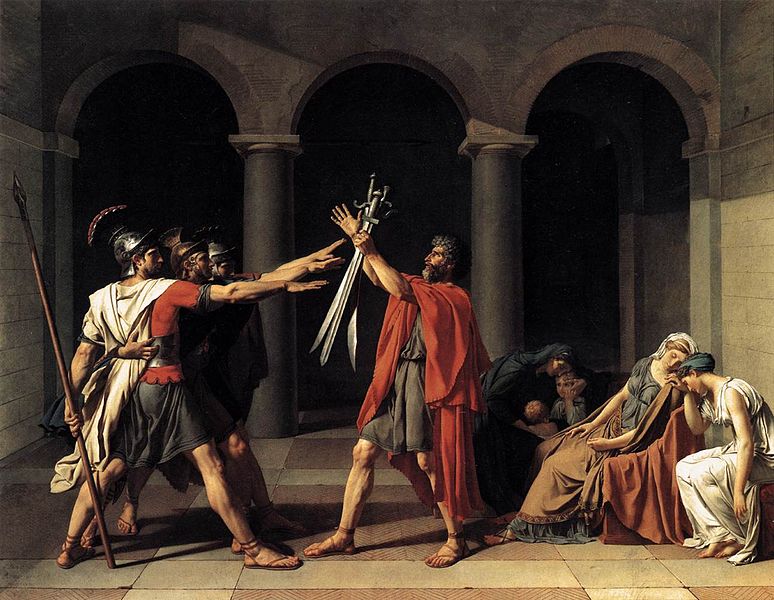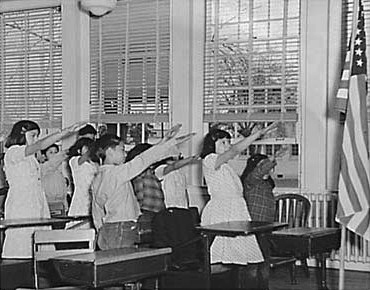In all cultures throughout the world, unspoken body-language, usually hand-motions, have become ways for people to show respect, friendship, aggression, fear or other emotions or feelings. But where do all these gestures, movements and aspects of body-language come from? Why, for example, do soldiers and officers salute each other? Why do we shake hands? Why do Chinese people rap their knuckles on the dining-table? Let’s find out together…
The Handshake
The handshake has been a universal greeting for centuries…literally centuries. It goes back to Ancient Greece! What is today seen as a sign of respect, greeting and friendship, evolved out of the ancient custom of displaying open hands to another person.

In shaking hands, both parties displayed a lack of weaponry (swords, daggers and other knives) with which to cause harm. This showed that each party had enough respect for the other, or felt comfortable enough in each other’s presence, not to bring weapons into a meeting or engagement. Shaking hands proved this, as it indicated that neither party was armed.
The Salute
Ah, the salute. Famously used by soldiers and army officers the world-over. But what does it actually mean?
Saluting the Flag
The salute as we know it, as a hand-movement up to the forehead and down again, is the abridged, modern version of a much older, and far more elaborate movement or gesture which existed in earlier times.
The origins of the salute vary, depending on who you talk to. Some say that it goes all the way back to Medieval times. Knights dressed in full battle-armour would raise their visors to each other, as a sign of mutual respect, and it’s suggested that this may be one origin story of the salute, despite the fact that there isn’t much evidence to support this.
Some say it goes even further back, and that it was a hand-gesture to protect one’s eyes from the glare of the sun, when ancients stared up to the skies to pay respect to the Gods.
As heroic and fascinating as these origin-stories are, the truth is actually far less complicated. The salute is actually the evolution of the removal of one’s headgear!
Back when wearing hats was far more common, it was a mutual sign of respect and politeness to remove one’s hat or cap, either in the presence of a superior, or as a greeting. It was considered rude to keep one’s hat on in the presence of others, because it meant they couldn’t see your whole face, and suggested that you weren’t paying them proper attention and courtesy.
 Winston Churchill tipping or doffing* his trademark homburg,
Winston Churchill tipping or doffing* his trademark homburg,
outside 10 Downing Street
The salute therefore evolved out of the movement of reaching up to grasp the brim of one’s hat to be raised as a sign of respect or courtesy. It used to be that the hat, once removed, was swept downwards, followed by a bow. You might see this in some period movies. Obviously too time-consuming, it was eventually shortened to the modern salute – a quick, sharp movement to the hairline, before restoring the hand and arm to one’s side.
— — — —
*Doffing is an older English term, meaning to remove an article of clothing. The opposite of the still-used ‘Don‘ (as in to don one’s uniform).
Chinese Knuckle-Tapping
This is a rather obscure custom. I’d only ever read of it, and never seen it, or done it myself until a relative of mine did it while out at a family dinner.
Next time you’re out at a Chinese restaurant with friends or family, and someone pours you a cup of tea, curl the three middle fingers of your right hand and rap your knuckles twice on the table. Considered a silent ‘Thank You’ gesture (for when you can’t speak, such as when your mouth is full), this gesture and custom goes back all the way to Imperial China.
 Chinese Knuckle-Tapping
Chinese Knuckle-Tapping
It is said to have come from the Qianlong (“Ch’yen Long“) Emperor, who ruled China for much of the 18th Century (in fact, over sixty years!). The emperor enjoyed travelling incognito around China to be closer to his subjects. Accompanied by servants, he did anything to blend in as much as possible, and so instructed his servants not to bow or kowtow to him under any circumstances, so as to maintain his incognito.
 The Kowtow. Literally meaning ‘Knocking Head’ (Kow – ‘Knock’, Tow – ‘Head’), this ancient Chinese form of respect lasted well into the 20th century, but is rare today
The Kowtow. Literally meaning ‘Knocking Head’ (Kow – ‘Knock’, Tow – ‘Head’), this ancient Chinese form of respect lasted well into the 20th century, but is rare today
To keep up his facade of being just another Chinaman, the emperor even took to pouring tea for his servants – something completely unprecedented in Chinese history. Legend goes that the receiving servant bent three fingers and rapped his knuckles on the table two times, to represent the act of kowtowing to the emperor. His middle finger was his head, his two other fingers representing his arms.
The Middle Finger
The legend surrounding the origins of the Middle Finger supposedly date back to the Battle of Agincourt. When the French captured English longbowmen, they sliced off their middle fingers, rendering them incapable of drawing their longbows. Flicking up the finger was a sign of defiance and showing that the English still had the upper hand.
True?
Not on your life.
You can draw a bow with any fingers on your hand. So chopping one off doesn’t automatically make it impossible to fire an arrow! And besides, the origins of the Middle Finger go back even further.
Just like the handshake, the Middle Finger dates back to Ancient Greece. And it’s meaning hasn’t changed much in 2000 years!
Ever wondered why the Middle Finger is considered rude? The Greeks can tell you.
It’s because it looks like a dick.
Start ’em while they’re young…
Extending the middle finger while keeping the others curled was a crude representation of an erect penis, with the knuckles of the clenched fingers making up the testicles. Thus – giving ‘The Finger’ to someone was the same as flashing your privates in their faces!
The Straight-Arm Salute
Made famous by the Nazis in the 1930s, the straight-arm salute supposedly goes back to Roman times…
…only it doesn’t.
It’s been incorrectly assumed for centuries that the straight-arm salute, as portrayed in this painting from the 1780s…

…was a a salutation from Roman times. The only problem is…it isn’t! No reliable sources from original Roman texts, paintings, sculptures, frescoes or artworks of any kind depict anything like the gesture shown in the painting above.
In fact, it’s questioned whether or not the salute even EXISTED before 1784, which was the year in which the painting (by Jacques-Louis David) was produced!
This painting is the basis of almost all belief in the “Roman Salute”, despite the fact that there is no evidence that the Ancient Romans themselves ever used it, or invented it. And it was depicted in artwork ever since!
Its influence led to it being used in the 1920s by the Italian Fascists under Mussolini, and this eventually spread to other organisations and nations.
It was most famously adopted for use by the Nazis in the 1930s, all the way up until the end of the Second World War in Europe, in May of 1945.
In the late 1800s, up until the Second World War, the salute was used by Americans, as well! Called the ‘Bellamy Salute‘, it was used by American citizens when taking the Pledge of Allegiance!
 Before the war – American school-children saluting the flag, 1941
Before the war – American school-children saluting the flag, 1941
Unsurprisingly, this practice ceased in the 1940s when American officials noticed an embarrassing similarity between their ‘Bellamy Salute’ and the Nazi Salute. It was thereafter that the now, more familiar hand-over-heart gesture was adopted. The change between salute and hand-on-heart was officially made in 1942, when the United States Flag Code was updated.
 After the war – American school-children pledging allegiance to the flag, 1950s
After the war – American school-children pledging allegiance to the flag, 1950s
Today, rendering this salute in Germany, Austria and the Czech Republic is illegal, and considered highly offensive for obvious reasons.
Peace/Victory Sign

Popularised by Winston Churchill during the Second World War, the “Victory” (later, the “Peace”) sign, with the split index and middle fingers raised, has become an almost universal symbol.
The ‘V’ symbol, thus created, has meant many different things over the years. In Ancient Rome, it meant the number 5 (hence why ‘5’ in Roman numerals is a ‘V’). In some countries, the back of the hand facing outwards while doing a V is considered an insult (“Up yours!” basically).
The origins of this, together with the ‘Middle Finger’ also have false origins in the medieval wars between England and France. Sticking up two fingers was a sign of defiance at still being able to shoot the enemy with a longbow. However, this assertion can only be dated back to the 1980s, and is untrue.
But the V with palm outwards, meaning peace or victory, is believed to have originated in Europe during the Second World War. Starting in 1941, many countries on the Allied side, such as Great Britain, Belgium, the Dutch and eventually, the Americans as well, used the ‘V for Victory’ signal as a sign of solidarity and defiance against the German Nazi aggressors.
This sign eventually melted into the “V for Peace” sign, common starting from the 1960s onwards, and which survives to the present day.